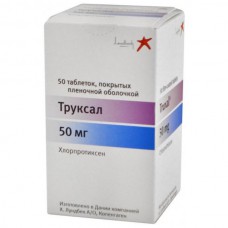Expiration date: 06/2026
Release form and composition:
Tablets, coated dark brown, film-round, biconcave, with a diameter of 8 mm.
One tablet contains chlorprothixene hydrochloride 25 mg
Excipients: corn starch, lactose monohydrate, copovidone, glycerol 85%, microcrystalline cellulose, croscarmellose sodium, talc, magnesium stearate.
The composition of the film-coating: Opadry OY-S-9478 brown (E 172 E 171) RM 1,030
50 pcs. - Plastic containers.
100 pieces. - Plastic containers.
Tablets, coated dark brown in color, oval film, lenticular, size 6.5 x 9.5 mm.
Pharmachologic effect:
Antipsychotics (antipsychotic), thioxanthene derivative. It has antipsychotic, sedative and mild antidepressant effect.
Antipsychotic effect Truxal due to its ability to block dopamine receptors. With the blockade of these receptors is associated as antiemetic and analgesic effect of the drug. Truxal able to block the serotonin 5-HT2-receptors, apha1-adrenergic receptors, and histamine H1-receptor, than due to its adrenoblokiruyuschee, antihypertensive and antihistamine effect.
Pharmacokinetics:
Absorption and distribution
Once inside Chlorprothixenum is rapidly absorbed from the gastrointestinal tract. Cmax of the active substance in the blood plasma is reached after 2 h. Bioavailability is about 12%.
Chlorprothixenum crosses the placental barrier in small amounts excreted in breast milk.
Metabolism and excretion
T1 / 2 is about 16 hours.
The metabolites have no antipsychotic activity, excreted in the feces and urine.
Indications:
- Psychosis, including schizophrenia and manic states, occurring with psychomotor agitation, agitation and anxiety
- Withdrawal syndrome in chronic alcoholism and drug addiction
- Hyperactivity, irritability, agitation, confusion in elderly patients
- Behavioral disorders in children
- Depression, neurosis, psychosomatic disorder
- insomnia
- Pain (in combination with analgesics).
Dosage and administration:
When psychosis (including schizophrenia and manic states) at the beginning of treatment the drug is prescribed in a dose of 50-100 mg / day, followed by a gradual increase to optimum effect - usually up to 300 mg / day. In some cases the dose may be increased up to 1200 mg / day. Usual maintenance dose is 100-200 mg / day.
Truxal daily dose is usually divided into 2-3 doses. Given the expressed sedative effect Truxal, a smaller part of the daily dose is recommended to take during the day, but most - in the evening.
For the treatment of abstinence syndrome in chronic alcoholism and drug addiction daily dose is 500 mg in 2-3 doses. The treatment is usually 7 days. After the disappearance of the manifestations of withdrawal symptoms gradually reduce the dose. Maintenance dose - 15-45 mg / day - to stabilize the condition, reduces the risk of another binge.
Older patients in the presence of hyperactivity, irritability, agitation, confusion drug administered in a dose of 15-90 mg / day, usually in 3 doses.
Babies for the correction of behavior Truxal prescribe a dose rate of 0.5-2 mg / kg body weight.
With depression, especially combined with anxiety, stress, Truxal can be used as monotherapy or as an adjunct to antidepressant therapy. When neuroses and psychosomatic disorders involving anxiety and depressive disorders drug prescribed up to 90 mg / day, usually 2-3 hours. Since the application of Truxal not develop addiction or drug dependence, the drug can be used for a long time.
When insomnia appoint 15-30 mg in the evening for 1 hour before sleep.
When pain syndrome Truxal administered in doses ranging from 15 mg to 300 mg in combination with analgesics.
Side effects:
CNS: the beginning of treatment may be drowsiness, accommodation disorders, rarely - dizziness, rarely - extrapyramidal symptoms, in some cases - reducing the seizure threshold.
From the digestive system: at the beginning of treatment - dry mouth, rarely - constipation with prolonged use (especially in high doses) can cholestatic jaundice.
Since the cardiovascular system: at the beginning of treatment - tachycardia possible orthostatic hypotension (especially when used in high doses).
From endocrine system: rarely - dysmenorrhea long-term use (especially in high doses) - galactorrhea, gynecomastia, weakening of potency and libido.
On the part of metabolism: at the beginning of treatment may increase sweating during prolonged use (especially in high doses) - increased appetite, weight gain.
From hemopoiesis system: in rare cases - benign transient leukopenia and hemolytic anemia.
Allergic reactions: seldom - skin rash.
Adverse effects arising early in treatment, often disappear as its continuation.
Contraindications:
- CNS depression of various origin (including those caused by alcohol, barbiturates, opioids)
- Coma
- Vascular collapse
- Disease of the blood
- pheochromocytoma
- pregnancy
- Lactation (breast-feeding)
- Hypersensitivity to the drug.
Truxal not recommended for use during pregnancy and lactation.
Chlorprothixenum crosses the placental barrier in small amounts excreted in breast milk.
Special instructions:
Truxal should be used with caution in patients with epilepsy, Parkinson's, in severe cerebral arteriosclerosis, the tendency to collapse, with severe cardiovascular and respiratory failure, when expressed violations of the liver and / or kidney disease, diabetes, prostatic hypertrophy.
Against the background of Truxal possible false positive result during immunobiological urine pregnancy test falsely elevated levels of bilirubin in the blood, changes in the QT interval on the ECG.
Chlorprothixenum may decrease seizure threshold, therefore, while the application Truxal and antiepileptic drugs may need a dose adjustment in patients with recent epilepsy.
During treatment the patient is recommended to refrain from drinking alcohol, avoid high insolation.
Effects on ability to drive vehicles and management mechanisms
During drug treatment Truxal should avoid activities that require high concentration of attention and fast psychomotor reactions (including the management of vehicles, machinery service, at the height of the work).
Overdose:
Symptoms: drowsiness, hypo or hyperthermia, extrapyramidal symptoms, convulsions, shock, coma.
Treatment: should be as soon as possible after admission to gastric lavage, we recommend the use of the sorbent. It is necessary to take measures aimed at supporting the activities of the respiratory system and cardiovascular system. Do not use epinephrine (adrenaline), as this may lead to a subsequent reduction in blood pressure. Seizures can be cut short diazepam, extrapyramidal symptoms - biperidenom.
Drug Interactions:
Chlorprothixene depressing effect on the CNS can be enhanced while the use of anesthetics, opioids, sedatives, hypnotics, antipsychotics, as well as ethanol and ethanol-preparations.
Chlorprothixene anticholinergic action is enhanced by concomitant use of anticholinergics, antihistamines, antiparkinsonian agents.
In an application with Truxal enhanced effect of antihypertensive drugs.
Simultaneous application chlorprothixene and epinephrine can cause hypotension and tachycardia.
Chlorprothixene ability to block dopamine receptors reduces the effectiveness of levodopa action.
Perhaps the emergence of extrapyramidal disorders, while the application Truxal and phenothiazines, metoclopramide, haloperidol, reserpine.
Conditions and terms:
List B. The drug should be stored in a place inaccessible to children at temperature not exceeding 25 ° C. Shelf life - 5 years.



